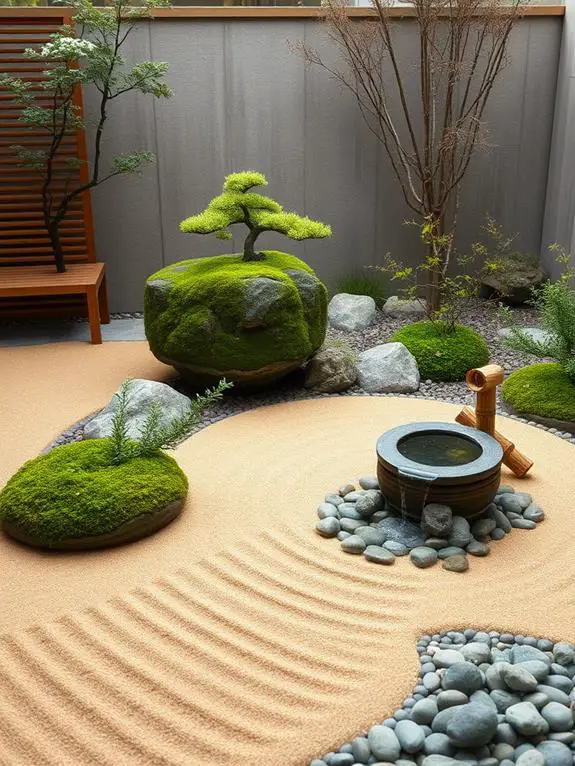Transform your outdoor space into a tranquil Zen garden with these five tips. First, choose a calm, secluded spot with good drainage and pleasant views. Next, incorporate essential elements like a focal point, flowing water, and raked sand or gravel. Select calming, low-maintenance plants such as bamboo or Japanese maples for natural beauty. Create balance by dividing your space into thirds and using meandering paths for flow. Finally, maintain simplicity by focusing on a few key elements and using soft colors and natural materials. These steps will help you craft a serene oasis where you can unwind and find inner peace. Discover how each element contributes to your garden's harmony.
Key Takeaways
- Choose a secluded area with partial shade and good drainage for your garden's location.
- Incorporate essential Zen elements like a focal point, flowing water, and raked sand or gravel.
- Select calming, low-maintenance plants such as bamboo, Japanese maples, and evergreens.
- Create a balanced design using the rule of thirds and strategic placement of elements.
- Maintain simplicity by focusing on a few key elements and using soft colors and natural materials.
Choose the Right Location
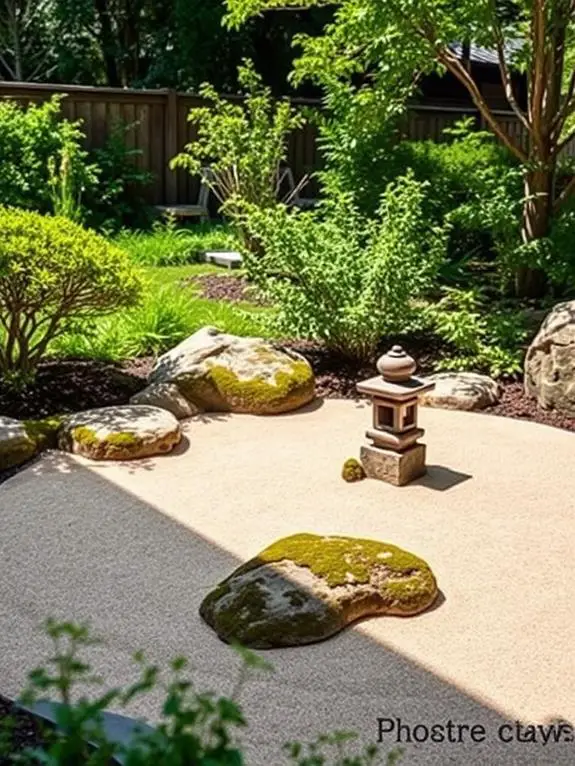
The foundation of a successful Zen garden lies in its location. You'll want to find a spot that feels naturally calming and secluded. Look for an area in your yard that's away from noisy streets or busy walkways. Consider how the sun moves across your property throughout the day. A partially shaded area can be ideal, offering a cool retreat during hot summer afternoons. Think about the views from this space, too. If you can see a lovely tree or a distant hillside, that's perfect! Don't forget to check for good drainage, as standing water can ruin your garden's tranquility. While planning your garden, keep in mind that site improvements may offer inspiration for enhancing your outdoor space. Consider how user feedback influences updates in various contexts, including garden design. Once you've found the right spot, take a moment to sit there and imagine your future Zen oasis. You'll know it's right when you feel a sense of peace wash over you.
Incorporate Essential Zen Elements
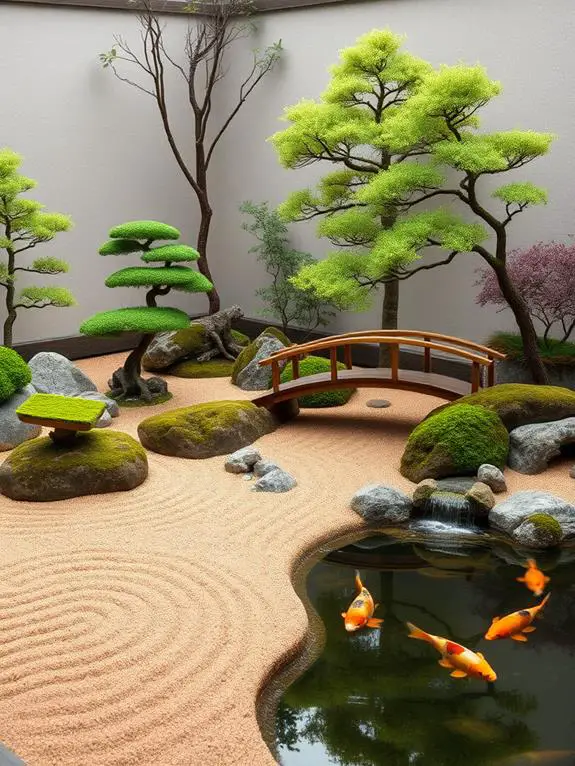
Immerse yourself in the heart of Zen garden design by incorporating its essential elements. Start with a focal point, like a striking boulder or a serene Buddha statue, to anchor your garden's energy. Add flowing water with a small fountain or bubbling stream to soothe your senses and create a calming atmosphere. Don't forget the importance of sand or gravel; rake it into gentle waves to represent flowing water and inspire meditation. While creating your Zen garden, keep in mind that site maintenance may temporarily limit access to online resources for design inspiration. However, this limitation can encourage more personal creativity in your garden planning. Introduce carefully placed plants, like Japanese maples or bamboo, to add natural beauty and texture. Remember, less is more in a Zen garden, so choose each element thoughtfully. Incorporate a seating area where you can relax and absorb the tranquil surroundings. By thoughtfully blending these elements, you'll create a peaceful oasis that invites reflection and rejuvenation throughout the summer months.
Select Appropriate Plants
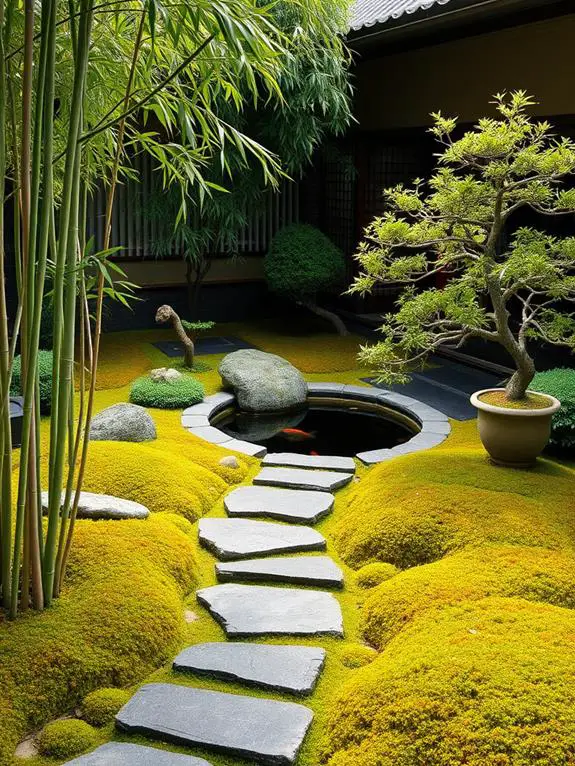
Once you've established the basic structure of your Zen garden, it's time to focus on selecting appropriate plants. Choose species that evoke a sense of calm and tranquility, such as bamboo, Japanese maples, or mosses. These plants not only look serene but also require minimal maintenance, allowing you to spend more time enjoying your garden than tending to it. To enhance the aesthetic appeal of your Zen garden, consider incorporating stylish herb garden decor that complements your chosen plants and overall design theme.
Consider incorporating evergreens for year-round interest and texture. Dwarf conifers or carefully pruned shrubs can create beautiful focal points that anchor your garden's design. Don't forget about the soothing power of water-loving plants like irises or sedges near a small pond or water feature. Remember, less is often more in a Zen garden, so select a few key plants that complement each other and the overall peaceful atmosphere you're aiming to create.
Create a Balanced Design
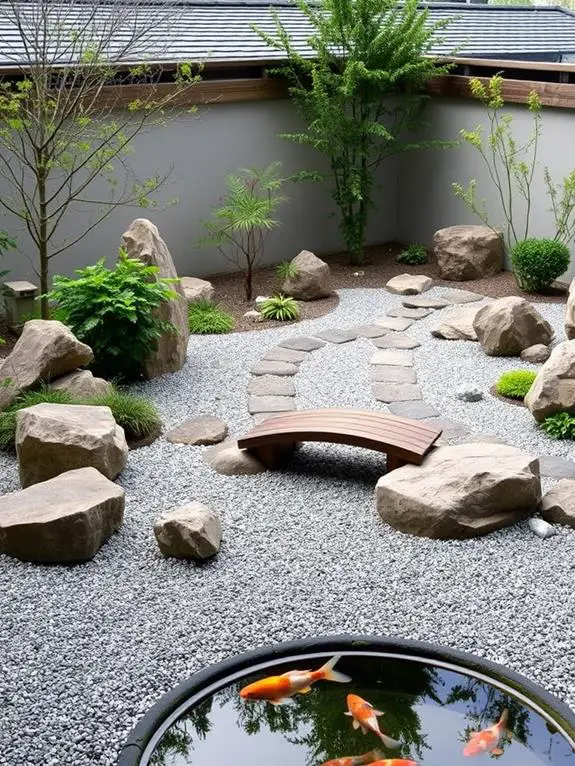
After selecting your plants, it's important to create a balanced design in your Zen garden. Start by dividing your space into thirds, both horizontally and vertically. Place larger elements, like rocks or statues, at key intersections to anchor your design. You'll want to create a sense of flow, guiding the eye through the garden with meandering paths or carefully placed plants. While designing, keep in mind that site enhancements may inspire new ideas for your garden layout. Regular updates to your design can help maintain interest and tranquility in your space.
Don't forget about negative space – areas left intentionally empty can be just as important as filled spaces. They give your eyes a place to rest and emphasize the beauty of surrounding elements. Mix textures and heights to add depth and interest. Soft, billowing grasses can contrast nicely with smooth river stones. Remember, symmetry isn't necessary for balance. Instead, aim for an overall feeling of harmony that'll make your garden a tranquil retreat.
Maintain Simplicity and Tranquility
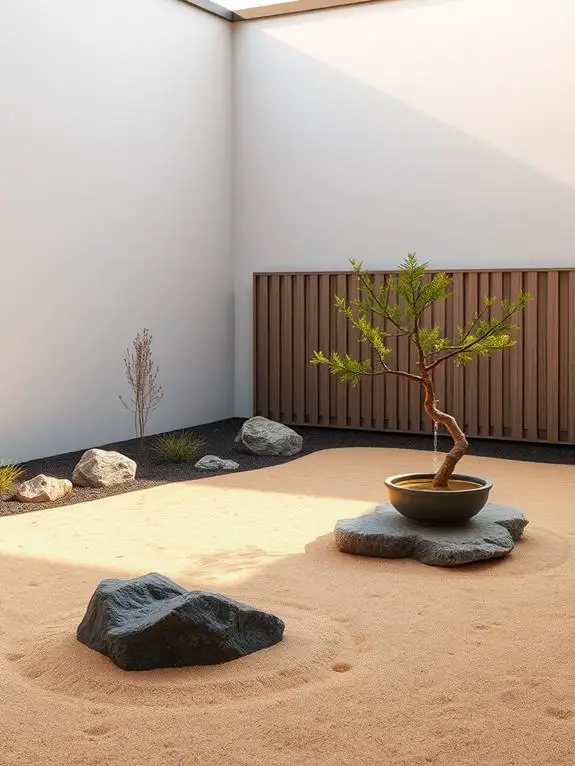
Simplicity reigns supreme in a true Zen garden. To maintain this tranquil atmosphere, you'll want to keep your design clean and uncluttered. Choose a few key elements that speak to you, like a carefully placed rock or a single, striking plant. Remember, less is often more in Zen aesthetics. While summer Zen gardens focus on serenity, you can also draw inspiration from cozy winter courtyards to create a year-round peaceful retreat. As you work on your garden, focus on creating a sense of calm and balance. Soft, muted colors and natural materials will help soothe your senses and invite peaceful contemplation. Consider incorporating a small water feature, like a gentle fountain, to add a soothing auditory element. The gentle trickle of water can help mask any outside noise, further enhancing the tranquil atmosphere. By embracing simplicity and prioritizing tranquility, you'll create a serene space that offers a welcome retreat from the hustle and bustle of daily life.
Frequently Asked Questions
How Much Does It Cost to Build a Zen Garden?
Building a zen garden's cost can vary widely, depending on your vision and resources. You'll find that a small, simple garden might set you back $500-$1,000, while larger, more elaborate designs could reach $20,000 or more. Your expenses will include materials like sand, rocks, and plants, as well as any structures or water features you'd like to add. Don't forget to factor in labor costs if you're not going the DIY route. Remember, creating tranquility doesn't always have to break the bank!
Can I Create a Zen Garden in a Small Apartment Balcony?
Picture a tranquil oasis right outside your apartment door. You can definitely create a zen garden on your small balcony! Start with a shallow tray filled with sand or fine gravel. Add a few carefully chosen rocks, miniature plants, and a small water feature. Don't forget a tiny rake to create soothing patterns. Hang wind chimes and place a comfortable cushion nearby. You'll soon have a cozy retreat where you can relax and find your inner peace, even in the heart of the city.
Are There Any Feng Shui Principles to Consider for Zen Gardens?
Yes, there are several feng shui principles you can apply to your zen garden. You'll want to create a balance between yin and yang elements, using both smooth and rough textures. Incorporate the five elements: wood, fire, earth, metal, and water. Arrange rocks and plants in odd numbers, as this is considered more harmonious. Pay attention to the flow of energy, or chi, by creating curved paths rather than straight lines. Finally, include a focal point to draw the eye and promote relaxation.
How Long Does It Take to Complete a Zen Garden Project?
You've decided to create a zen garden? Well, buckle up, because you're in for a wild ride that might take anywhere from a weekend to… the rest of your life! In reality, the time it takes depends on your garden's size and complexity. A small indoor zen garden could be done in a day, while a larger outdoor project might take weeks. Don't rush it, though. Creating your peaceful oasis is a journey to be savored, not a race to be won.
Can I Add Water Features Like Fountains to My Zen Garden?
You can definitely add water features like fountains to your zen garden. They're a wonderful way to enhance the peaceful atmosphere. The gentle sound of flowing water can soothe your senses and create a calming ambiance. You'll find that fountains come in various styles, from traditional stone basins to modern sculptures. When choosing one, consider its size and how it'll fit into your garden's overall design. Remember, the goal is to create a harmonious space that invites relaxation and tranquility.

